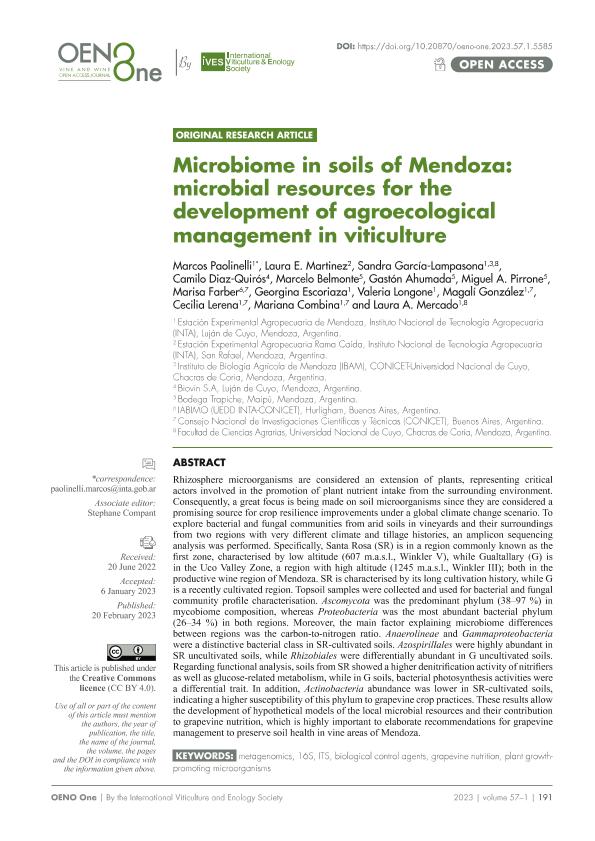Artículo
Microbiome in soils of Mendoza: microbial resources for the development of agroecological management in viticulture
Paolinelli, Marcos ; Martinez, Laura Elizabeth; Garcia Lampasona, Sandra Claudia; Diaz Quirós, Camilo; Belmonte, Marcelo; Ahumada, Gastón; Pirrone, Miguel Ángel; Farber, Marisa Diana
; Martinez, Laura Elizabeth; Garcia Lampasona, Sandra Claudia; Diaz Quirós, Camilo; Belmonte, Marcelo; Ahumada, Gastón; Pirrone, Miguel Ángel; Farber, Marisa Diana ; Escoriaza, María Georgina; Longone, María Valeria; González, Magalí Lucía Rosa
; Escoriaza, María Georgina; Longone, María Valeria; González, Magalí Lucía Rosa ; Lerena, Maria Cecilia
; Lerena, Maria Cecilia ; Combina, Mariana
; Combina, Mariana ; Mercado, Laura Analia
; Mercado, Laura Analia
 ; Martinez, Laura Elizabeth; Garcia Lampasona, Sandra Claudia; Diaz Quirós, Camilo; Belmonte, Marcelo; Ahumada, Gastón; Pirrone, Miguel Ángel; Farber, Marisa Diana
; Martinez, Laura Elizabeth; Garcia Lampasona, Sandra Claudia; Diaz Quirós, Camilo; Belmonte, Marcelo; Ahumada, Gastón; Pirrone, Miguel Ángel; Farber, Marisa Diana ; Escoriaza, María Georgina; Longone, María Valeria; González, Magalí Lucía Rosa
; Escoriaza, María Georgina; Longone, María Valeria; González, Magalí Lucía Rosa ; Lerena, Maria Cecilia
; Lerena, Maria Cecilia ; Combina, Mariana
; Combina, Mariana ; Mercado, Laura Analia
; Mercado, Laura Analia
Fecha de publicación:
02/2023
Editorial:
International Viticulture and Enology Society
Revista:
Oeno One
e-ISSN:
2494-1271
Idioma:
Inglés
Tipo de recurso:
Artículo publicado
Clasificación temática:
Resumen
Rhizosphere microorganisms are considered an extension of plants, representing critical actors involved in the promotion of plant nutrient intake from the surrounding environment. Consequently, a great focus is being made on soil microorganisms since they are considered a promising source for crop resilience improvements under a global climate change scenario. To explore bacterial and fungal communities from arid soils in vineyards and their surroundings from two regions with very different climate and tillage histories, an amplicon sequencing analysis was performed. Specifically, Santa Rosa (SR) is in a region commonly known as the first zone, characterised by low altitude (607 m.a.s.l., Winkler V), while Gualtallary (G) is in the Uco Valley Zone, a region with high altitude (1245 m.a.s.l., Winkler III); both in the productive wine region of Mendoza. SR is characterised by its long cultivation history, while G is a recently cultivated region. Topsoil samples were collected and used for bacterial and fungal community profile characterisation. Ascomycota was the predominant phylum (38–97 %) in mycobiome composition, whereas Proteobacteria was the most abundant bacterial phylum (26–34 %) in both regions. Moreover, the main factor explaining microbiome differences between regions was the carbon-to-nitrogen ratio. Anaerolineae and Gammaproteobacteria were a distinctive bacterial class in SR-cultivated soils. Azospirillales were highly abundant in SR uncultivated soils, while Rhizobiales were differentially abundant in G uncultivated soils. Regarding functional analysis, soils from SR showed a higher denitrification activity of nitrifiers as well as glucose-related metabolism, while in G soils, bacterial photosynthesis activities were a differential trait. In addition, Actinobacteria abundance was lower in SR-cultivated soils, indicating a higher susceptibility of this phylum to grapevine crop practices. These results allow the development of hypothetical models of the local microbial resources and their contribution to grapevine nutrition, which is highly important to elaborate recommendations for grapevine management to preserve soil health in vine areas of Mendoza.
Archivos asociados
Licencia
Identificadores
Colecciones
Articulos (IABIMO)
Articulos de INSTITUTO DE AGROBIOTECNOLOGIA Y BIOLOGIA MOLECULAR
Articulos de INSTITUTO DE AGROBIOTECNOLOGIA Y BIOLOGIA MOLECULAR
Articulos(CCT - MENDOZA)
Articulos de CTRO.CIENTIFICO TECNOL.CONICET - MENDOZA
Articulos de CTRO.CIENTIFICO TECNOL.CONICET - MENDOZA
Citación
Paolinelli, Marcos; Martinez, Laura Elizabeth; Garcia Lampasona, Sandra Claudia; Diaz Quirós, Camilo; Belmonte, Marcelo; et al.; Microbiome in soils of Mendoza: microbial resources for the development of agroecological management in viticulture; International Viticulture and Enology Society; Oeno One; 57; 1; 2-2023; 191-205
Compartir
Altmétricas



